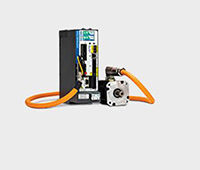Werner Geissler GmbH has been producing precision turned parts for 40 years, predominantly for the automobile and automotive supply industry. Geissler recently sought out a solution to accelerate cycle times for a test bench that performed the final inspection of precision turned parts. At the heart of the system was a pneumatic rotary indexing table that had reached its limits and was no longer able to produce the desired shorter cycles.
The goal of Geissler’s custom machine building department was to replace the existing pneumatic table with a more efficient electrical solution—as the automotive industry demands that final inspection results be 100%.

The rotary indexing table is not the core element of the system, which makes it easily accessible for installation and maintenance.
Weiss, a leader in rotary tables and automation, and its subsidiary Weiss North America, Inc., reviewed Geissler’s test system situation and recommended a conversion to its directly driven TO series rotary indexing table to cut the cycle time.
The main issue being tension screws for the common rail injection systems for a specialist automotive supplier. The production from 25 CNC automatic lathes runs through a single test bench. A rotary indexing table feeds the components to the test stations, where cameras, lasers and spreading fingers check the dimensions in 2.6 sec cycles. If the machine fails, inspections need to be performed by hand—which is costly, time-consuming and occurs approximately every four weeks.
This is when regular maintenance of the pneumatic rotary indexing table takes place as the short cycle times push the table to its mechanical limits.
Additionally, after one month, the shock absorbers and parts of the mechanics need to be replaced. This frequent maintenance was taken into account during the development, as the rotary indexing table was kept easily accessible so that the shock absorber unit could be replaced quickly.
These collective factors led Geissler to realize it was time to replace the entire rotary table. To achieve the required cycle times, the whole thing needed to be operated electronically—which is where Weiss came in.
Initial Weiss consultation suggested a fixed-cycle, electro-mechanical rotary indexing table from its TC series. This would have halved the previous switching time of one second. Upon further investigation, the parties discovered that the direct-drive, user programmable, TO220C torque rotary indexing table, with a switching time of just 0.3 sec under current conditions, was suitable. This would cut the cycle time of the test bench from 2.6 to 1.9 sec.
Saving valuable cycle time wasn’t the only benefit the TO delivered as fast indexing times, simple integration and easy programming are all benchmarks. The TO direct-drive rotary indexing table is also virtually maintenance free, which eliminated the need to regularly replace the shock absorbers of the pneumatic rotary indexing table.

The user programmable TO220C torque rotary indexing table reduced the cycle time of the test from 2.6 to 1.9 sec.
Installation of the TO presented advantages as the rotary indexing table is easily accessible and not the core element of the whole system—as often is the case. Although the programmable, gentle approach ramps of the TO eliminate the hard impacts caused by the pneumatics, some unpleasant oscillating motions did occur. The external arrangement of the rotary indexing table meant that the whole construction acted like a torsion spring, which led to unpleasant undulations because of the direct drive’s larger dynamics. Bracing the substructure solved the problem.
Finally, Geissler’s master electrician leveraged the Weiss Application Software (WAS), which enabled simple and intuitive commissioning of the system’s most important parameters.
The graphic user interface series also provided clear and in-depth programming with a faster (approximately 15 min) set-up and smooth operation. Additionally, it only took a few minutes to connect the inverter to the control system via the Profibus. The WAS also made it possible to optimize the approach ramps and further cut switching times.
The sum of these elements meant that the test machine could get back to checking quality on schedule.
Weiss
www.weissna.com
Filed Under: Automotive, Drives (dc), MOTION CONTROL, MORE INDUSTRIES





Tell Us What You Think!